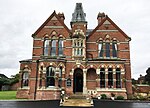Lugwardine

Lugwardine is a village and civil parish in Herefordshire, England, to the east of Hereford. It lies on the north-east bank of the River Lugg, which gives the village its name. The population of the civil parish taken at the 2011 Census was 1,721.The place-name 'Lugwardine' is first attested in the Domesday Book of 1086, where it appears as Lucvordine. It appears as Lugwurthin in the Pipe Rolls of 1168. The name means 'enclosure or homestead on the (river) Lugg'.The village lies on the A438 road; Lugwardine Bridge takes this road across the Lugg. There is a public house in the village called The Crown and Anchor.St Mary's Roman Catholic High School is in the village. There is also a primary school, shared with neighbouring Bartestree.
Excerpt from the Wikipedia article Lugwardine (License: CC BY-SA 3.0, Authors, Images).Lugwardine
Hereford Road,
Geographical coordinates (GPS) Address Nearby Places Show on map
Geographical coordinates (GPS)
| Latitude | Longitude |
|---|---|
| N 52.066 ° | E -2.66 ° |
Address
Hereford Road
Hereford Road
HR1 4RY , Bartestree
England, United Kingdom
Open on Google Maps






